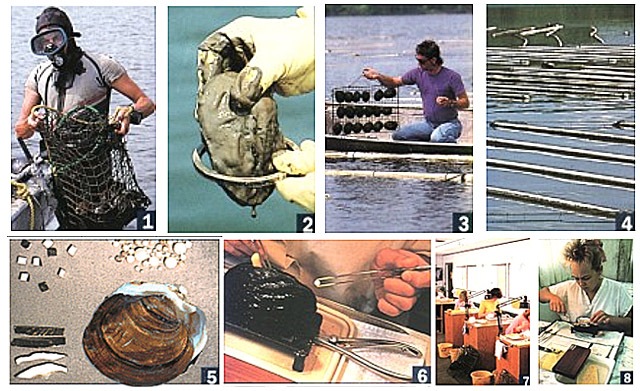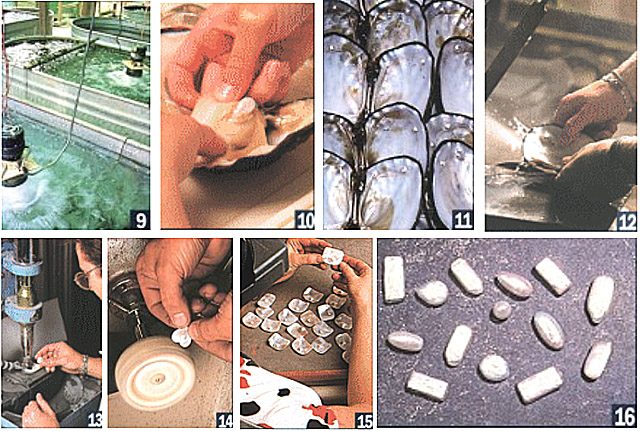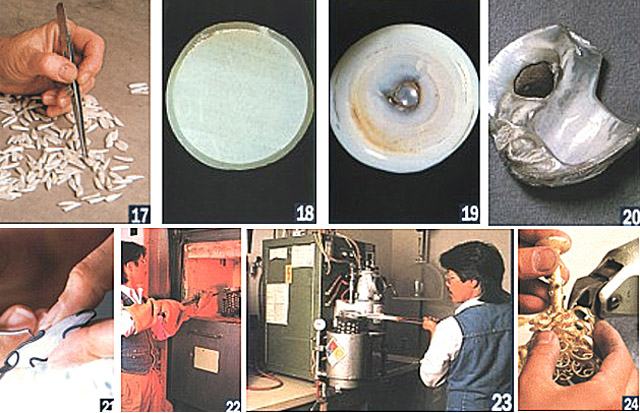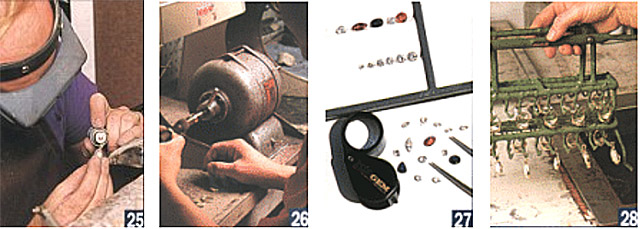quote:

For over 40 years John Latendresse collected natural pearls from our own rivers and lakes, maintaining a sizeable collection. Over 30 years of research and development were invested towards the refining and reinventing the culturing techniques introduced from Asia. Results were astonishing.
Not only did they improve upon the culturing process, allowing the pearls to grow for an additional three to Eve years in monitored waters, but our own native river mussels produced remarkably beautiful cultured pearls of superior quality and unique shapes.

The American pearl story begins with the lone diver (1). Mother shells are harvested individually from the rivers (2). Natural habitats are not destroyed by dredging the river floor, therefore the younger mussels are left to continue growth and breeding. With great care, the mussels are place into a net (3) allowing ample room for each mussel to feed, grow, and reproduce at a higher rate than its natural habitat. The nets are then transported to the pearl farm where the water quality and temperature are constantly monitored (4).
The cultured pearl begins with a mother-of-pearl nucleus (5). In fact, about 95% of the world's round cultured pearls were nucleated `with a bead carved from the shell of an American mussel. The nucleation process is a skill that takes many years to master (6, 7, 8). A mother-of-pearl nucleus is shaped and placed strategically within the mantle tissue of the mussel. Because of their great size, the American mussels can be multi-nucleated with a variety of shapes, producing bountiful harvests of pearls.

Next, the sensitive nucleated mussels are eased back into their natural environment by way of the "intensive care unit" (9). From here, the mussels are on their way to the pearl farm, where they will work their magic for 3-5 years. Most Japanese pearls are cultured for only one years or less - resulting in less durability and beauty.
Waiting is always difficult. When the 3-5 year growing period is up, the pearls are anxiously harvested and sorted (10). The pearls are cultured in a variety of original shapes. The most popular is the Dome® - immediately recognized as a cultured pearl of high quality, rich luster, and breathtaking orient. The Dome® begins as a large blister pearl in the shell of the mussel (11). The shell is thoroughly cleaned (12), the rough shapes of the Dome'® are cut from the shell (13), the Hnal shaped for each one is meticulously calibrated, and the edges are polished to a smooth finish (14). After the Dome ® is perfected, it is graded, sized, and matched by the pearl specialists (15). It is then ready for the artistry of its gold setting.

There is also a unique and clarity. The short—term growth of the Japanese cultured pearl creates a very thin nacre coating, clearly shown in the cross section photo (18). In contrast, a natural pearl will have thick layers of nacre, shown as rings in the cross section photo (19), which give the pearl durability, beauty and value. We combine these desirable qualities of the natural pearl and the predictability ofthe cultured pearl by culturing the pearls for years instead of months. Pearls from the Tennessee River Pearl Farm are never bleached or dyed. They maintain their natural beauty and durability. The nucleus for each cultured pearls is a calcium carbonate substance, such as mother-of-pearl. A grain of sand or a pebbles can never production of sand or a pebble can never produce a pearl - this is simply a myth. lf a pebble should end up inside the mussel, the shell will grow around the pebble, but will not adhere to the shell itself (20).
Work does not end after the pearls are harvested. American artisans and goldsmiths create lines offine jewelry. Sculpting the initial wax design (21 ), using the “lost wax” process (22) in casting the "trees" of mountings with gold (23, 24), polishing and setting the mountings with pearls and gems (25), and putting the Hnishing touches to each masterpiece (26). Some designer pieces are hand-fabricated. Geologists inspect all gems - pearls, diamonds, and colored stones - that become part of the jewelry (27). American pearls are so durable, that they may even be cleaned with uItra-sonic with no harm to the pearls (28). Each piece receives a final inspection before being offered to the retailer.


 SMP Silver Salon Forums
SMP Silver Salon Forums

 Silver Jewelry
Silver Jewelry

 American Fresh Water Pearls
American Fresh Water Pearls







